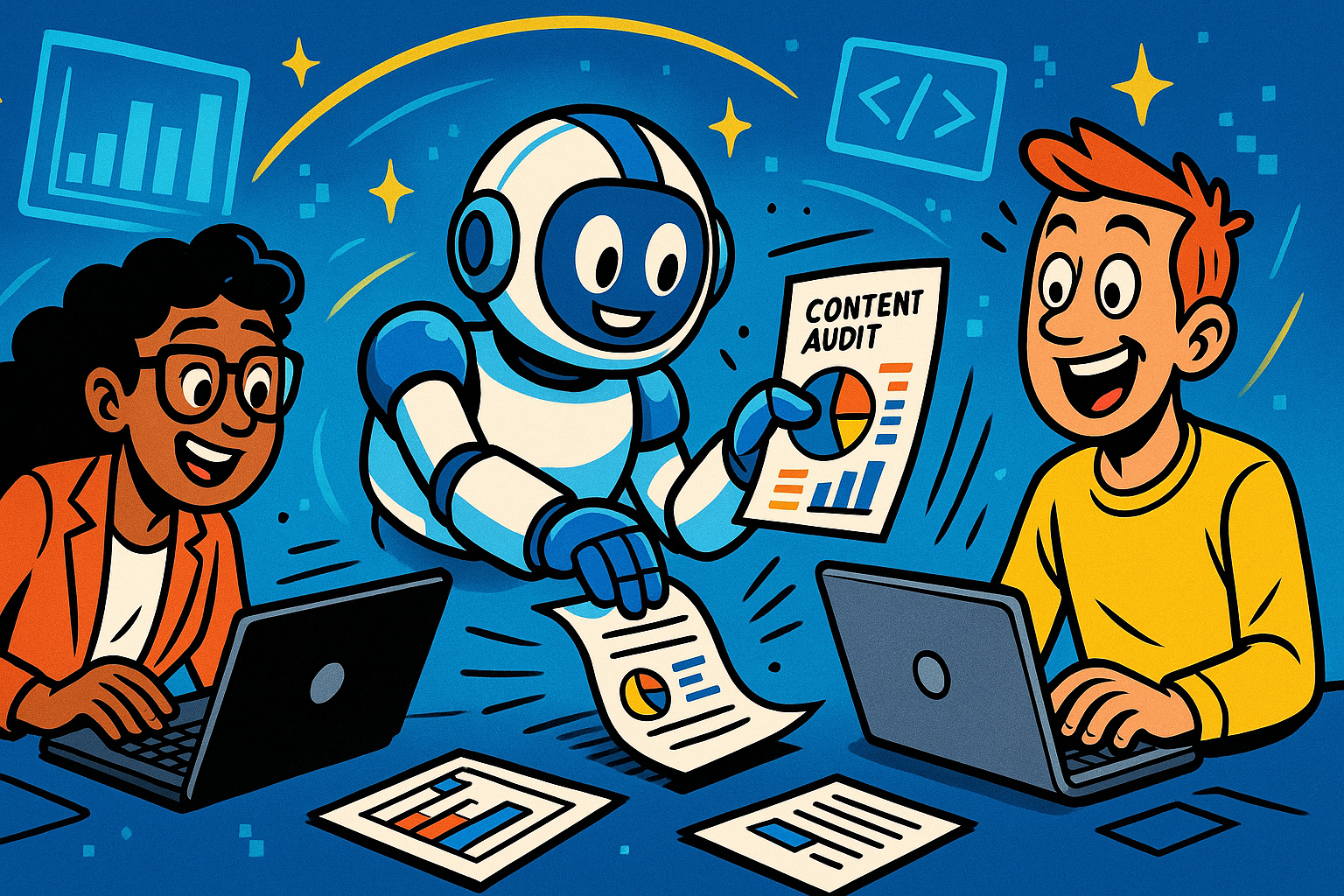💡 Quick Takeaway: Answer Engine Optimization (AESEO) helps AI brands get cited inside AI answers (ChatGPT, Perplexity, Copilot, Google AI Overviews). The best AESEO services combine entity mapping, cite-able content, third-party corroboration, and prompt-panel testing—then measure share-of-answer and pipeline lift. For B2B SaaS, this means more qualified trials, demos, and SQLs from questions your buyers actually ask.
Your buyers aren’t scrolling through ten blue links anymore “they’re reading a single synthesized answer in ChatGPT, Perplexity, Copilot, or Google’s AI Overviews”. If your brand isn’t one of the sources those answers cite, you’re invisible at the exact moment someone is choosing what to try, book a demo for, or buy.
For mid-market and growth-stage B2B SaaS teams running content-led or PLG motions, that invisibility shows up on the dashboard: fewer SQLs, softer demo rates, slower Trial→Paid, rising CAC, and stalled ARR.
The fix isn’t “more blogs.” It’s Answer Engine Optimization (AESEO), making your facts, definitions, and examples so clear (and corroborated) that answer engines feel safe citing you inside the answer.
This post is your practical playbook. You’ll learn what the best AESEO services actually include, how to run them in-house or with an agency, and how to instrument results so they ladder up to revenue goals (Demo rate ↑, Trial→Paid ↑, ACV ↑, CAC ↓). We’ll cover the exact steps “mapping entities, publishing cite-able answer blocks, earning third-party proof, running a weekly prompt panel, and measuring Share-of-Answer” plus the risks to avoid and lightweight examples to model.
💡 Read on to become the source AI answers cite and turn that visibility into trials, demos, and pipeline.
Table of Contents
What Is Answer Engine Optimization (AESEO)?
AESEO is the work of making your brand the trusted source that AI answer engines (ChatGPT, Perplexity, Copilot, Google AI Overviews) quote or reference inside their answers. Instead of chasing page-one rankings, you’re earning citations where buyers actually read the decision-shaping response.
How it’s different from traditional SEO
- Goal: SEO = rankings; AESEO = citations inside answers where a single response is synthesized.
- Content style: SEO tolerates long articles; AESEO favors crisp “answer blocks” (120–180 words) with a clear claim, a number, and an example.
- Proof: SEO can lean on volume; AESEO demands corroboration (the same fact appearing on credible third-party sites).
- Measurement: SEO = sessions/positions; AESEO = share-of-answer, citation counts, and assisted demos/trials.
The AESEO Playbook (7 Steps to Become the Source AI Answers Cite)
This is your end-to-end path from “invisible in AI answers” to “regularly cited.” Each step is simple, action-oriented, and measurable, so your team knows what to do this week, how to do it, and how it moves demos, trials, and revenue.
1) Diagnose Demand & Map Entities (Weeks 1–2)
What: Capture the exact questions your ICP asks and the entities (company, products, features, use cases, benchmarks, people) your brand must be recognized for.
Why: Answer engines assemble responses around entities + corroborated facts, not generic keywords.
How:
- Mine sales calls, Gong notes, support tickets, docs searches, community threads.
- Turn each question into a query-style H3 you can answer in 120–180 words.
- Draft a simple entity graph: Brand → Products → Features → Use cases → Proof points.
Instrumentation: Baseline brand/entity presence (are you cited at all?), existing answer screenshots, Search Console queries, trial/demo attribution notes. Start with an SEO Content Audit to benchmark visibility and technical gaps.
Owner: Content strategist + PMM.
Time/Cost: 1–2 weeks | Mostly time.
Risks: Overfitting to keywords vs. questions; skipping buyer-language.
Micro-Checklist: Buyer questions collected • Entity list drafted • Top 10 answer targets picked • Baseline citations/screenshots saved.
2) Fix “Be-Found” Fundamentals (Weeks 1–3, parallel)
What: Make your site and docs legible to answer engines.
Why: If your organization, authors, and products aren’t clear and consistent, engines won’t trust or cite you.
How:
- Clean About/Team/Contacts (real people, expertise).
- Consistent product pages + docs with crisp definitions and examples.
- Basic Organization/Person/Product schema; add FAQ blocks to key pages (plain language).
- Ensure downloadables (PDFs) include on-page HTML equivalents.
Instrumentation: Crawl for missing titles/H1s, duplicate pages, schema presence.
Owner: SEO lead + web dev + docs owner.
Time/Cost: 1–3 weeks | Low–moderate dev/design.
Risks: Over-templating “SEO text” that says nothing; broken docs navigation.
Micro-Checklist: Org/person/product clarity • FAQ markup on 3–5 core pages • Docs indexable & consistent • PDF→HTML parity.
🤙 Want a technical checklist walkthrough? Book a quick review
3) Produce “Cite-able” Assets (Weeks 2–6)
What: Create/upgrade definition, comparison, how-to, and stats pages written in answer blocks (120–180 words) that can be easily quoted.
Why: Engines prefer clear, verifiable, self-contained explanations with numbers and examples.
How:
- Build 10 answer blocks around your top buyer questions (each an H2/H3).
- Add 1 real number (benchmark, range, formula) and 1 crisp example per block.
- Include author bylines (with expertise) and link out to credible sources.
Instrumentation: Track publication dates, internal links, and on-page answer block presence; collect first citations.
Owner: Content + SME + editor.
Time/Cost: 3–6 weeks | Medium content lift.
Risks: Vague claims; no numbers; walls of text.
Micro-Checklist: 10 answer blocks published • Each has a number + example • Expert byline present • Outbound corroboration added.
4) Corroborate on Trusted Third-Party Sources (Weeks 3–8)
What: Place the same facts (definitions, stats, frameworks) on reputable external surfaces: community posts, vendor-neutral blogs, docs directories, neutral comparison pages, podcasts/interviews, lightweight research briefs.
Why: Engines cross-check claims; multi-source corroboration increases your chance of being cited.
How:
- Pitch guest “explainers” (not promos) and data snippets.
- Publish light research (method + sample + findings) others can link.
- Contribute to category glossaries or Q&A hubs.
Instrumentation: List of external placements, live URLs, and which answer blocks they support.
Owner: Content lead + PR/Community.
Time/Cost: 3–8 weeks | Outreach time + light content.
Risks: Low-quality placements; mismatched audiences.
Micro-Checklist: 4–6 third-party corroborations live • At least 2 neutral sources • Links align to your answer blocks.
5) Prompt-Panel Testing Across Engines (Start Week 4; ongoing)
What: Run a fixed panel of prompts in ChatGPT, Perplexity, Copilot, and Google AI Overviews against your target topics, save screenshots, and log citations.
Why: You need a feedback loop to see which assets win citations and where to iterate.
How:
- Standardize 10–15 prompts (category definition, evaluation criteria, vendor list, how-to).
- Test weekly, capture outputs, note which sources appear, and compare over time.
- Update answer blocks where you’re “near miss.”
Instrumentation: Share-of-Answer (SoA): % of panel runs where your brand appears as a cited source; Unique Citing Domains by engine.
Owner: SEO/Content ops.
Time/Cost: Ongoing | Low ops effort.
Risks: Changing models; overreacting to one-off results.
Micro-Checklist: Prompt panel defined • Weekly log running • Screenshots archived • “Near-miss” list queued for updates.
6) Measure Impact on Pipeline (Monthly)
What: Tie AESEO to demo/trial quality and revenue-adjacent metrics.
Why: Leadership cares about SQLs, Trial→Paid, ACV, CAC—not just visibility.
How:
- Dashboards: SoA, citation counts, sessions to answer pages, trial/demo starts, assisted conversions.
- Qualitative: ask “Where did you first learn about us?” in demo/trial forms; add “saw in [engine]” as an option.
- Compare cohorts (pre/post publication; exposed vs. non-exposed).
Instrumentation: GA4, form enrichment, CRM notes, screenshot archive.
Owner: RevOps + Growth.
Time/Cost: Ongoing | Low.
Risks: Shallow attribution; ignoring lag between visibility and pipeline.
Micro-Checklist: KPI board live • Form field updated • Monthly review cadence • Cohort notes logged.
7) Scale the Winners (Quarterly)
What: Expand topics and double-down on formats/placements that reliably earn citations.
Why: AESEO compounds when you cover the category with consistent, cite-able clarity.
How:
- Clone the structure for adjacent use cases, industries, and buyer roles.
- Refresh every 90–180 days; add new numbers, examples, screenshots.
- Turn answer blocks into sales enablement and support macros.
Instrumentation: Refresh calendar, content reuse tracker.
Owner: Content lead + PMM + Sales Enablement.
Time/Cost: Quarterly | Medium.
Risks: Topic bloat; drifting from buyer language.
Micro-Checklist: Refresh plan set • New topics prioritized by demand • Sales/support reuse shipped • Old content pruned.
What the “Best AESEO Services” Package Includes
- Entity & Knowledge Graph Audit (your brand, products, features, SMEs)
- Cite-able Content Production (definitions, explainers, stats, FAQs)
- Third-Party Corroboration Plan (neutral placements that back your claims)
- Prompt-Panel Testing across major answer engines
- Measurement & Reporting (Share-of-Answer, citations, assisted pipeline)
- Quarterly Refresh & Expansion (keep winning topics fresh and broaden coverage)
What Results Look Like (Outcomes You Can Expect)
Visibility inside answers
What you’ll see: Screenshots where your brand/page is named as a source for category definitions, evaluation criteria, vendor lists, or how-tos.
▶️ Target: Within 4–12 weeks, reach 30–50% SoA on your top 10 prompts (i.e., you’re cited in 3–5 of every 10 runs across engines).
More qualified visitors
What you’ll see: Higher-intent sessions landing on your answer-aligned pages (definitions, comparisons, how-tos).
▶️ Target: +15–30% lift in demo-worthy traffic to those pages vs. pre-AESEO baseline. Start with a free SEO Audit to benchmark before/after.)
Better sales conversations
What you’ll hear: Prospects say, “We saw your explanation in Perplexity/ChatGPT,” then repeat your numbers and framework back to you.
▶️ Target: Demo rate ↑ 10–25% on answer-aligned pages; sales cycle shorter on cohorts exposed to cited answers. (Have questions about proof points? Chat with us on LinkedIn for quick, example-driven guidance.)
Leading indicators (move first)
- SoA trending up by topic and engine.
- Unique citing domains increasing (owned + third-party).
- Mentions in communities and referral traffic from neutral placements rising.
- More branded queries that include your product/feature names (consistent entities pay off).
Lagging/commercial outcomes (follow)
▶️ Trial→Paid ↑, ACV ↑ (clearer value narrative), CAC ↓ (need less paid to reach consideration).
▶️ Attribution tip: Add “Where did you first hear about us?” with [ChatGPT / Perplexity / Copilot / Google AI Overviews] as options to capture assist.
How to Choose the Right AESEO Partner
1. Signs of a good partner
- Talks in terms of citations, sources, corroboration, not only “rankings.”
- Shows simple, concrete deliverables: answer blocks, schema basics, proof placements, prompt-panel log (grounded in AEO content best practices.
- Understand your niche (can explain your product in buyer language in 2–3 sentences, and knows what makes an AEO-ready SaaS blog guide useful to buyers).
- Commits to measurement: SoA, unique citing domains, sessions to answer pages, assisted trials/demos.
- Has a refresh cadence (quarterly) because answers evolve.
2. Questions to ask
✅ “What will you deliver in month one?” (Look for an answer-target list, entity map, and first answer blocks.)
✅ “How will we track citations across engines?” (Expect a prompt panel, screenshots, and SoA—and ask how their plan adapts to a zero-click SERP keyword strategy
✅ “Which third-party sites will we appear on and why?” (They should name credible, vendor-neutral outlets—not PBNs.)
✅ “What does a 90-day win look like for us?” (A clear SoA target plus a conversion metric, e.g., demo rate on answer pages.)
3. Red flags (bonus)
❌ Vague promises of “AI SEO” with no examples of citations.
❌ Heavy focus on volume (hundreds of posts) vs. clarity + corroboration.
❌ No plan to edit docs/product pages—only blogs.
❌ No screenshots or prompt logs; “trust us” reporting.
Roles & RACI (who does what)
| Step | DRI | Support | Review |
|---|---|---|---|
| Diagnose & Entities | Content Strategist | PMM, Sales | Head of Growth |
| Fundamentals | SEO Lead | Dev, Docs | PM |
| Cite-able Assets | Content Lead | SMEs, Design | Editor |
| Corroboration | Content Lead | PR/Community | Strategist |
| Prompt Testing | SEO/Content Ops | Analysts | Strategist |
| Measurement | RevOps | Growth | Leadership |
| Scale/Refresh | Content Lead | PMM, Enablement | CMO |
Risks & Anti-Patterns (read this twice)
AESEO fails quietly when teams ship volume without verifiable clarity. The pitfalls below are the most common reasons brands don’t get cited inside AI answers—even with “good” content.
1) Treating AESEO as “just more blogs” (no facts, no examples)
You don’t need longer posts, you need answer-ready blocks. When a page lacks a crisp claim, one real number, and a concrete example, answer engines have nothing safe to quote.
Impact: No citations; readers skim and bounce.
Spot it: Long paragraphs, vague claims, zero numbers.
Fix: Convert each H2/H3 into a 120–180 word answer block with:
- 1 clear claim (plain English)
- 1 real number (range, benchmark, % or SLA)
- 1 concrete example (use case or mini-scenario)
- Expert byline (who said it and why they’re credible)
✅ KPI to watch: % of target pages with answer blocks; citations/page.
2) No third-party corroboration (only owned claims)
Even great on-site content can be treated as unverified if it never appears elsewhere. Engines look for the same fact on neutral domains.
Impact: Low trust → no citations.
Spot it: Your best definition/number exists only on your blog.
Fix: Place the same facts on:
- Vendor-neutral blogs and industry glossaries
- Communities/Q&A and light data briefs
- Podcasts/interviews with a written summary
Target: 4–6 proof placements/quarter, each linking back to the matching answer block.
✅ KPI to watch: Unique citing domains per topic.
3) Inconsistent entities (product names, features) across site/docs
If “Smart Scoring” on marketing is “Signal Ranker” in docs, engines can’t reconcile what’s what.
Impact: Fragmented entity understanding; missed citations.
Spot it: Multiple labels for the same feature; author titles vary; schema missing.
Fix:
- Publish a 1-page naming guide (brand → products → features).
- Align site + docs to that guide.
- Add Organization/Person/Product schema to key pages.
✅ KPI to watch: % of top pages aligned to the naming guide; reduction in duplicate terms.
4) No screenshots/logs (wins unprovable, unrepeatable)
AESEO needs a paper trail. Without a weekly log, you can’t show progress or replicate what worked.
Impact: Budget skepticism; stalled momentum.
Spot it: No folder of prompt outputs; no SoA trendline.
Fix:
- Set a fixed prompt panel (10–15 prompts) across ChatGPT, Perplexity, Copilot, AI Overviews.
- Run weekly, save screenshots, record which domains are cited.
- Maintain a “near-miss” list and refresh those pages first.
✅ KPI to watch: Share-of-Answer (SoA) by topic/engine; # logged screenshots per week.
5) Attribution myopia (no “Where did you first hear about us?”)
Last-click analytics won’t capture assist from AI answers. Ask people directly.
Impact: Under-investing in what actually influences buyers.
Spot it: Forms lack a source question; CRM notes don’t mention AI engines.
Fix:
- Add a required, open-text field with quick options (ChatGPT/Perplexity/Copilot/AI Overviews).
- Tag answers in your CRM; report monthly.
✅ KPI to watch: % of submissions with field filled; # mentions of AI engines/month.
Frequently Asked Questions
Yes. Traditional SEO chases rankings; AESEO earns citations inside the answer itself. They reinforce each other, clean structure and credible content help both.
On focused topics with real corroboration, first citations often land in 4–12 weeks. Expect SoA and citing domains to move before the pipeline.
Not press releases. You need proof placements “vendor-neutral explainers, data briefs, community posts, interviews “places that repeat your key facts.
Absolutely. Start with 5 buyer questions, publish answer blocks, secure 2 neutral corroborations, and run a weekly prompt panel. Expand once SoA rises.
Final Thoughts
Answer engines decide in seconds whose facts and examples to trust. If your brand isn’t cite-able “clear, corroborated, and easy to quote” you’ll miss buyers at the moment of choice.
The playbook is simple: map entities, publish short answer blocks with real numbers, earn third-party proof, run a weekly prompt panel, and track Share-of-Answer through to demos and revenue. Do this consistently and you’ll see Demo rate ↑, Trial→Paid ↑, ACV ↑, and CAC ↓ without chasing content volume for its own sake.
Want help becoming the source AI answers cite? Book an AESEO Audit with The Rank Masters and leave with your first 10 answer targets, a proof-placement plan, and a live prompt panel.




